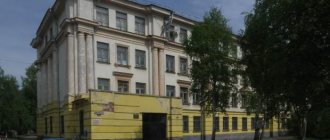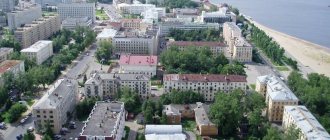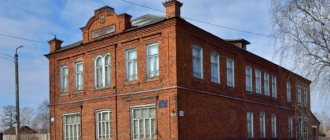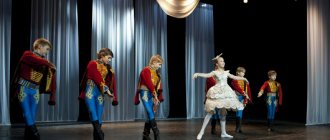Solvychegodsk: areas, recreation, excursions, museums and churches, cuisine and restaurants, shopping and shops, attractions of Solvychegodsk.
- New Year tours
to the North-West - Last minute tours
to the North-West
The city of Solvychegodsk grew from a small settlement of the 13-15 centuries, which in those days was founded for salt extraction. Soon the settlement turned into a full-fledged city, but not a single industrial enterprise was built there. This allowed Solvychegodsk to maintain its special atmosphere of a quiet, almost rural province.
To this day, the architecture of Solvychegodsk is predominantly wooden; many houses are recognized as historical monuments. True, architecture alone was not enough to attract tourists, so at the beginning of the 20th century a balneological resort was built here, which operates all year round.
A little bit of history
The history of the city is closely connected with the history of the Stroganov family of wealthy merchants and salt industrialists. At the beginning of the 16th century, the Stroganovs set up the first salt brewery near the city of Usolsk near Lake Solenoye, known since the 14th century. From that moment on, the city began to develop rapidly. Salt producers supported artistic crafts, collected rare icons and books, and donated huge sums to churches. In the 17th–19th centuries. Solvychegodsk was considered one of the important centers of Russian art. Here they excelled in the art of embroidery, embossing and filigree, and enamel painting.
At the beginning of the 18th century, the saltworks closed and economic growth ceased. At the end of the 19th century. Revolutionaries were exiled here, and Comrade Stalin also served his exile here. In 1937, Solvychegodsk was included in the Arkhangelsk region.
Ferry to Solvychegodsk
Now, when I walk around the city, I remember my first visit with a smile. Until this day, I only knew about ferries, which is how people get to the city in the summer, only from Soviet films, where a wooden ferry floated along the river, moving along a stretched rope. And when I saw a barge with a boat, I asked: “Where is the ferry?”
Ferry station on Vychegda
“So that’s who he is,” they answered me.
-Where is the raft and rope?
– Well, we live in the 21st century, such ferries are a thing of the past.
Sights and museums
Solvychegodsk Historical and Art Museum
The museum complex includes: the Annunciation Cathedral, the Church of the Savior, the Stroganov family tomb (1826), the J. V. Stalin Museum and the school of folk crafts. The museum collection is based on monuments of ancient Russian fine art of the 16th and 17th centuries. The museum displays collections of ancient Russian sculpture, decorative and applied and folk art, handwritten and early printed books, Russian, Soviet painting, graphics, a collection of materials on the history of the region, etc. The pride of the exhibition is signed Stroganov icons, facial embroidery, artistic silver - all 16- 17th century.
The museum complex includes: the Annunciation Cathedral, the Church of the Savior, the Stroganov family tomb (1826), the J. V. Stalin Museum and the school of folk crafts.
At the museum you can book a sightseeing tour of the city, learn the secrets of ancient weaving and embroidery at the school of folk crafts, and visit the Annunciation Cathedral and Kuzakova Memorial House on a guided tour.
Address: st. Sovetskaya, 9; tel. (81837) 7-92-54. Every day from 9:00 to 17:00, except Mondays and the last day of each month.
Annunciation Cathedral (1560—1584)
The Annunciation Cathedral in Solvychegodsk is one of the oldest stone cathedrals in the North. Built during the Stroganov period, the five-domed temple majestically rises above the low urban buildings. The current chapters of the cathedral were built in the 18th century. At various times, the southern gallery was rebuilt; at the beginning of the 19th century, a bell tower was added, a wonderful panorama from which you can still admire today. It is worth noting that the Stroganovs did not skimp on the temple. Its interior decoration was magnificent: it was decorated with priceless utensils, luxurious icon frames, embroidered covers and covers for vessels with communion.
Unfortunately, all this has not reached our days. However, the surviving frescoes from 1600 and the iconostasis, which took on its current form in the 17th century, with icons of the “Stroganov school” give an idea of the former splendor of the temple. After the times of the Stroganovs’ power, the rich collection of icons was sold off or, using forged documents, written off allegedly due to disrepair. Today, the icon “Our Lady of the Don” by the sovereign icon painter Istoma Savin and the icon “Zosima and Savvatiy of Solovetsky”, a contribution of the Stroganov brothers, are kept here. On the northwestern side of the cathedral there is the Stroganov family tomb, where 28 tombstones from burials of the 16th and 17th centuries are collected. Near the Annunciation Cathedral there is Pearl Lake, in which, according to legend, the Stroganovs grew pearls to decorate icons.
Vvedensky Monastery
The Vvedensky Monastery with a tall cathedral in the “Moscow Baroque” style stands away from the bank of the Vychegda. This monastery was founded by the Stroganov brothers in 1565. Now it has been abolished, only the Church of the Entry of the Blessed Virgin Mary into the Temple remains (1689-1693). What is most striking about its interior is the huge seven-tiered carved iconostasis and icons of the same “Stroganov school.” Between the Vvedenskaya Church and Lake Solenoye there is a salt spring-fountain. And on the shore of the lake itself a salt pan has been preserved.
Church of the Savior (1697)
There is another church in the Baroque style in Solvychegodsk. The stone building, built at the end of the 17th century, was rebuilt at the end of the 19th century in the pseudo-Russian style. An extensive two-story chapel almost completely covered the façade of the temple; a hipped bell tower replaced the tiered one. Today the building is dilapidated and in a deplorable state; its only dome has not been preserved.
Solvychegodsk
House-monument of political exile
At the end of the 19th-20th century. People's Volunteers, the leaders of the uprisings, were sent to Solvychegodsk for settlement; Joseph Stalin also served exile here twice. In the house of Maria Prokopyevna Kuzakova, where Stalin rented a room, the furnishings of those years have been completely preserved.
House of the Pyankov merchants (1810)
The Pyankov House, a palace in the classicist style, is a unique building for the Arkhangelsk region and rare even for the entire North. The house was built in the first half of the 19th century by order of wealthy merchants; at the end of the 19th century it housed government offices, and during the Soviet era it served as a sanatorium. Today the house is empty.
Sanatorium
In 1923, a balneological mud resort was founded in Solvychegodsk based on healing mineral springs. For medicinal purposes, chloride-sulfate-sodium and hydrogen sulfide mineral waters, silt mud, and bromine waters are used here. The resort is good for improving the health of people with diseases of the musculoskeletal system, nervous system and gynecological problems.
The Stroganovs in the history of Solvychegodsk
But all this did not arise out of nowhere; this is where the famous surname pops up - the Stroganovs. The city acquired the severity and severity that is felt in the air thanks to these eminent people. By the way, it must be said that the boundaries of the settlement have hardly changed during the entire existence of Sol Vychegda. The layout has changed a little, the course of the Usolka River has changed, but in general time has stood still here and nothing has changed.
Stroganov mansions
Anika Stroganov, who came into inheritance at the age of 18, began active business activities in the city. Here, on the salt lake, he set up his first salt makers, subduing all the other salt makers. Having become a monopoly in the salt business, the Stroganov family began the development and extraction of iron ore; in addition, they traded furs and had their own scriptorium.
Not forgetting about the spiritual side of their lives, they donate a lot for the construction of churches, for painting icons and making church utensils. Why do they open huge workshops in their yards?
But life goes on as usual, trade routes change. The Stroganovs, already barons, moved closer to the capital at the end of the 17th century, and the life of Solvychegodsk froze for almost a century. The last thing their family leaves behind in the city is the Vvedensky Cathedral in the Baroque style. Ornate, rich, completely unusual at that time, completely outside the canon, which is why they did not want to consecrate the temple for a long time. The cathedral was built by Baron Grigory Stroganov, the same one with whom Peter the Great loved to consult and who had breakfast on a barrel of gold.
Vvedensky Cathedral of Solvychegodsk
And then oblivion came.
Solvychegodsk – a place of exile
In the 19th century, Solvychegodsk became a place of political exile. Quite a lot of interesting personalities were sent here. The most famous are Pushkin’s uncle, Pavel Hannibal, who loved to show off, shoot at six in the morning from a signal cannon and generally annoyed the local residents, for which he was transferred, due to numerous complaints from the townspeople, to Solovki. And also Joseph Dzhugashvili (Stalin), it’s not worth talking about him, he’s a well-known media personality. While serving his exile here, he escaped by dressing in a woman's dress. You can learn more about this side of the city’s history in another museum building where young Koba lived. The “Museum of Political Exile” houses an exhibition dedicated to political exiles.
Kuzakova's house, where Stalin served his exile
Seasons in Solvychegodsk
You can come to Solvychegodsk at any time. In autumn, everything dresses in orange-golden shades. The sky becomes leaden, already low, as if it falls on the shoulders of the buildings. The still bright sun provides the last warmth before the long frosty winter.
Solvychegodsk in winter
In winter, the city is very beautiful, everything is white, trees covered in frost sparkle in the sun, the dark water in the river contrasts sharply with the white snow, leaving a feeling of some kind of power of nature.
In summer, the city is surrounded by greenery, children frolic on the river, the most visited place is the Razgulyaevsky (duck) bridge, where you can feed the permanent residents of the Usolka River - ducks. By the way, some birds do not fly away until December. They are constantly fed, so they are not afraid of people and immediately swim as a flock as soon as someone stops on the bridge.
Solvychegodsk in summer
But spring is not the best period for tourists; at the end of March - beginning of April, the city goes through the stage of transformation from a cocoon into a butterfly. The roads are “falling”, slush, puddles, the snow becomes dark. The only joy is that this does not last long and by the end of April everything begins to live again. Many people start going to the river, waiting for the ice to break up. It’s an epic spectacle, I’ll tell you, when huge blocks of ice, bumping into one another, float down the river with a crash and noise, pushing each other to the shore. And in May the Vychegda flood begins.
Solvychegodsk in spring
Merchants in the history of Solvychegodsk
For about a century, Solvychegodsk lived a calm, sedate life, an ancient way of life without any special changes. In the 19th century, the Khaminov merchants began their activities in the city. Of course, in terms of their scope they cannot compare with the Stroganovs, but their activities clearly served as an example for them. After this merchant dynasty, many stone buildings in the classical style of the 19th century have been preserved in the city. Almost the entire center is built by the Khaminova merchants - the organizers of an almshouse, a gymnasium, vocational and secondary schools and zealous philanthropists. The museum has a separate complex located in one of the Khaminovs’ residential buildings. Here you can hear the story of how their family came to be.
House of merchants Khaminovs
Another building that does not fit into such a remote place is the house of the Pyankov merchants. If the architecture of the Khaminovs’ time were simple two-story buildings, then the Pyankovs’ house was a luxurious palace-style building with columns and two wings. But the fate of the house is quite sad, as is well written in the article “Thirty-three misfortunes of the Pyankov house.”
House of the Pyankov merchants
A fire, the death of the owner, litigation during the division of property, all these vicissitudes led to the fact that the house never became residential. The owner of the house sold the house for administrative premises to pay off her debts. Only after this did life begin to boil in the Pyankovs’ house: in Soviet times, the house had a drama theatre, a cinema, a resort, an evacuation hospital, a house of pioneers and many more interesting things. This is a completely different story, but quite interesting and requires a separate story.










